Jim Leyland has come out on several occasions and said that Jeremy Bonderman is one of the keys to any success the Tigers might enjoy in 2008. Bonderman’s second half swoon, which I attribute largely to his elbow pain that he finally fessed up to, clouded what was starting out to be a phenomenal season. An ERA of 8.50 over his last 9 starts, combined with the arm troubles meant that Bonderman finished with the highest ERA and lowest innings total since his rookie season. Like with Dontrelle Willis, we’ll delve into the pitch f/x data and see what we can find out about the veteran 25 year old pitcher.
What does he throw
Jeremy Bonderman throws 2 flavors of fastballs, a nasty slider, and the very occasional change-up. I used K-means clustering on the horizontal and vertical movement parameters, and the velocity to classify the pitches. The relative frequencies and mean velocity are listed below:
| Pitch | N | Velocity |
| 2seam | 327 | 91.4 |
| 4seam | 261 | 93 |
| Change | 55 | 85.2 |
| Slider | 358 | 83.8 |
And the following graph shows the movement of Bonderman’s pitches from the catcher’s perspective in inches.
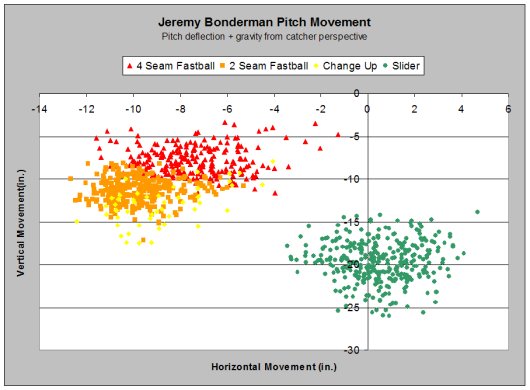
Both fastballs tail away from left handed hitters, with the 2 seamer having more lateral movement. The slider drops about 2 feet and dives away from the right handed hitter. I’m actually a little surprised that we don’t see more horizontal movement on the pitch. The change-up is hardly thrown, especially in relation to the number of stories that come out each year about it’s development.
Part of the problem with the change-up is that he doesn’t get enough downward movement on the pitch, because it ends up more like a batting practice fastball. Mike Fast when working with pitch f/x data likes to calculate the spin rate. Looking through Fast’s past work where he’s done these calculations, the spin rate for a change-up is in the range of 1500, give or take a few hundred depending on the pitcher. In the case of Bonderman his mean spin rate is 2155. As a point of comparison the spin rate on Bonderman’s fastballs are 2333 for the 2 seam and 2421 for the 4 seamer. The more backspin, the less sink so Bonderman’s change-up isn’t really behaving like a change-up.
Where does he throw it?
The scatterplots below show the pitch location, by pitch, from the catcher’s perspective. Each pitch has a graph for the pitches thrown to left handers and right handers. Reference lines are drawn such that the resulting box corresponds with a typical strike zone. So 0 on the horizontal axis represents the center of home plate and 0 on the vertical axis represents, well, the ground.
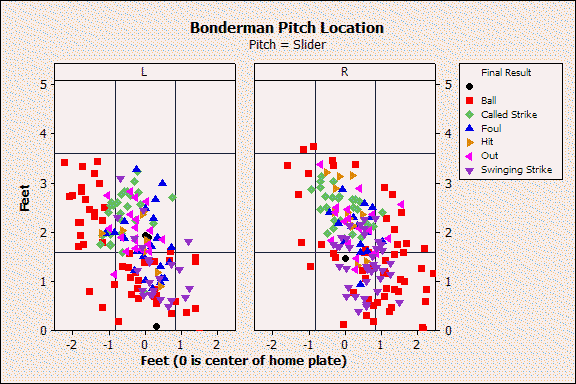
The slider is the bread and butter pitch where Bonderman gets the most swings and misses, many of which take place well outside of the strike zone. He also gets a fair number of called strikes right on the third base side black as the ball swings back – or at least fools the umpire enough into thinking that it is.
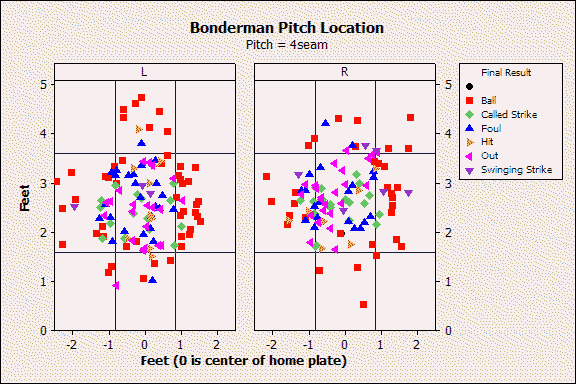
the 4 seam fastball is the one that Bonderman seems to have the most trouble controlling. Either by design or by accident, it seems to be up more than his other pitches.
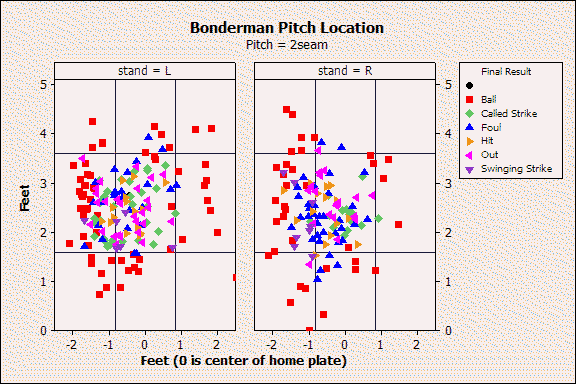
The 2 seam fastball is typically bearing in on the right handers and tailing away from the left handers. From watching Jeremy the last several years, his ability to harness that tailing action will often dictate the good starts from the bad starts.

Bonderman hardly throw the change-up to right handers, and hardly throws it period with the pitch only about 5% of his arsenal. If you’re interested int he full size graph feel free to click the thumbnail.
If you prefer a tabular view, that is included as well here:
Left Handed Batters
| Pitch | Ball | Call Str | Foul | Hit | Out | Sw Str | Swing % | Contact% | Total |
| 2seam | 66 | 36 | 29 | 19 | 27 | 6 | 44% | 93% | 183 |
| 4seam | 53 | 15 | 25 | 14 | 23 | 3 | 49% | 95% | 133 |
| Change | 21 | 10 | 4 | 6 | 7 | 3 | 39% | 85% | 51 |
| Slider | 55 | 28 | 25 | 11 | 19 | 23 | 48% | 71% | 161 |
| Total | 195 | 89 | 83 | 50 | 76 | 35 | 46% | 86% | 528 |
Right Handed Batters
| Pitch | Ball | Call Str | Foul | Hit | Out | Sw Str | Swing % | Contact% | Total |
| 2seam | 41 | 15 | 38 | 20 | 19 | 8 | 60% | 91% | 141 |
| 4seam | 40 | 22 | 23 | 10 | 25 | 7 | 51% | 89% | 127 |
| Change | 2 | 1 | 1 | 50% | 1 | 4 | |||
| Slider | 69 | 27 | 17 | 17 | 18 | 44 | 50% | 54% | 192 |
| Total | 152 | 64 | 79 | 48 | 62 | 59 | 53% | 76% | 464 |
Those second half woes
Delving into this analysis I thought I’d be able to turn up something really cool regarding Bonderman’s second half struggles. Maybe a consistent failure to locate a pitch, or his slider flattening out and not biting. There had to be some graphical evidence of whatever caused Bonderman to go from striking out 4 batters for every free pass he issued to walking a batter every other inning and allowing 8 homers in his final 48 innings of the season. Alas I have nothing.
I fail to see any discernible changes in pitch location when looking before and after his 7/13 start against the Mariners.
In terms of movement, graphically it showed nothing so I went with the hard measurements below. Pfxx is horizontal movement, adjpfx_vert is vertical movement, and adj_start_speed is velocity.
Results for Pitch = 4seam
Variable Pre-Post Mean StDev
pfxx 1st Half -7.528 1.610
2nd Half -7.310 1.939
adjpfx_vert 1st Half -7.596 1.504
2nd Half -7.866 1.721
adj_start_speed 1st Half 93.220 1.143
2nd Half 92.865 1.460
Results for Pitch = Change
Variable Pre-Post Mean StDev
pfxx 1st Half -9.109 1.255
2nd Half -8.937 2.075
adjpfx_vert 1st Half -14.172 2.403
2nd Half -13.016 2.154
adj_start_speed 1st Half 84.264 1.691
2nd Half 85.464 1.637
Results for Pitch = Slider
Variable Pre-Post Mean StDev
pfxx 1st Half 1.104 1.317
2nd Half 0.2258 1.5330
adjpfx_vert 1st Half -18.720 1.673
2nd Half -20.017 2.537
adj_start_speed 1st Half 84.598 1.456
2nd Half 83.409 1.967
The differences are minimal, and given the newness of the system and the various stadium deployments I’d consider the bulk of this as random variation. The only possible change would be the slider which had more drop and less horizontal movement in the second half, perhaps an indication it isn’t quite as tight?
Also notice that there weren’t appreciable changes in velocity, which is good news from a shoulder health perspective.
Outlook
Once again we head into a season wondering if this will be the year for Bonderman. Last year I really thought that “this was it” because of the way he threw for the first 100 plus innings. People like to point to the lack of a legitimate 3rd pitch as a real limiter for Bonderman. His success early on last year shows that either the change-up was legitimate, or he doesn’t in fact need the 3rd pitch. What he does need is health.
Bonderman will only be 25 this season, but has over 900 major league innings on his right arm. Twice now he has suffered tenderness in his elbow late in the season. Will this be a recurring problem? Only time will tell. But until Bonderman can put together a full season people will continue to question 1. his stuff, 2. his ability, 3. his mental toughness, etc. He does appear to be pretty ripped coming into camp this year and he’s sporting a new tattoo, so he’s got that going for him.
One final note, I know you’ve read several pages now with no mention of Bonderman’s first inning struggles. You know the struggles. A quarter of the runs Bonderman has allowed in his career have come in the first inning. The thing is, when I wrote my program to parse the data and build my pitch database I neglected to grab the inning. The reason for this: I’m an idiot. Changing the code is easy enough to have things re-parsed. But everything after that point becomes time consuming, so it ain’t happening right now. Sorry.
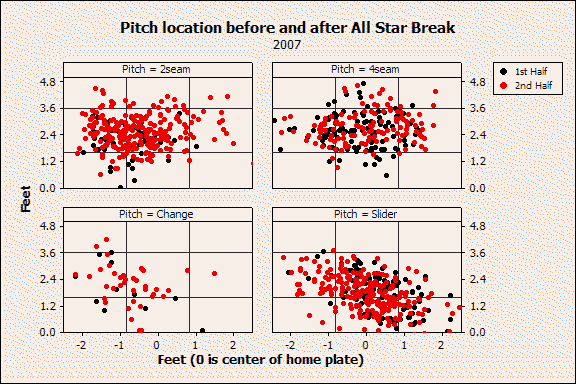
Great, great stuff. You’re totally on about people’s conception of Bondo’s struggles. He can do fine with the fastballs and the slider, even if his change isn’t great. It’s all about that elbow for him this year.
But as great as this article is, I’m not sure I agree with you about the reason his change doesn’t work well. You say that it behaves like a slow fastball, and doesn’t move much different.
There is another man who has had a great, great changeup for twenty years now, and his is indistinguishable from his fastball in movement. http://www.hardballtimes.com/main/article/anatomy-of-a-player-tom-glavine/
Maybe Bondo doesn’t hide it well enough, and is tipping it off? The movement issue alone isn’t reason enough for his change to be no good.
Is there anyway we can figure out a stat such as WHIP per pitch or batting avg against a certain pitch? For example, what would be his WHIP using the slider data only?
I don’t know what ESPN considers a “hard-hit ball,” but in 2006, Bonderman’s slider was the least likely pitch in all of baseball to be hit hard:
“Well-hit average against”
Bonderman’s slider .105
Rivera’s cutter .111
Santana’s change .112
http://insider.espn.go.com/mlb/playoffs2006/insider/news/story?id=2637860&action=login&appRedirect=http%3a%2f%2finsider.espn.go.com%2fmlb%2fplayoffs2006%2finsider%2fnews%2fstory%3fid%3d2637860
That’s pretty good company. If his control comes back this year, even without a great change he can dominate.
Great writeup! I loved reading it and I especially love the second half comparison (even if it was inconclusive).
As I brought up a bit on the forum, I think part of Bonderman’s problem is that he doesnt have a lot of “hop” on his 4-seam like a lot of other pitchers. If you note, he doesnt get many swings and misses with either fastball. A lot of the top pitchers – Santana, Bedard, Verlander – and K-pitchers – Lincecum, O. Perez, J. Vazquez – all get a lot of their strikes swinging with fastballs in the upper half of the zone or high, out of the zone. These guys also all have a lot more vertical movement on their fastball.
I really think that part of Bonderman’s problem is that his fastball is more hittable than the velocity guns make scouts think. Anyone know if Bonderman tends to use his fastball more in the 1st inning than in later innings? Something like trying to establish it early?
This is great stuff, Bill. And the above sentiments are right: his slider is dominant.
Put me in the “lack of a third pitch” crowd, however. Guys like JB are dominant when his big pitch – in this case, his slider – is working. But as anyone who’s pitched knows, some days, it just isn’t the same.
I would argue that between a few “off” days with the slider and his sometimes lack of command with his fastball (whether for health reasons or otherwise), it costs him runs and games – I think most observers would agree that he doesn’t show the same “battle” as a Robertson, Rogers or even Verly on the staff – whereas the top of the rotation pitchers learn how to win without their best stuff. Truth be told, his repertoire is more “closer stuff” than “starter stuff.”
A halfway decent off-speed pitch can be the equalizer, whether it be a straight change or traditional curveball (which few people throw any more).
It puts another plane – speed adjustment – into the hitters’ mind, rather than just location as his two fastballs, slider and current change (from your analysis) are essentially all “hard” stuff, w/in 10 mph.
Can he be good w/o the “third pitch?” Sure. But does the lack of a semi-effective third prevent him from taking the “next step” as a more consistent starter? I think so.
I foresee frequent links back to this and the D-Train pitch f/x post throughout the season. Definitely a resource provided as a public service, Bill.
Question – any word on if all MLB parks will be fitted with the carmeras and what-not to get this data up for all games in ’08? These posts are fascinating and as more complete data becomes available I would think analysis like this would really start to take off.
I know that GMs, scouts, etc. have been slow to accept Sabremetics, but this type of data seems like it could come into favor with the baseball establishment a little easier. Scouts love the radar gun. Seems like those pitch dispersion charts are just a natural evolution from the “gun”.
I will be interesting to see how this might affect the game.
One thing I noticed about Bonderman in ’07 was a bit of a dip in velo over prior years. Where he was topping out at 95-96 with his four seamer in ’06 and prior, he only seemed to be hitting 93 or so last year. He seemed to have greater movement with the 2 seamer than he had in previous years, though. Perhaps he was making a concerted effort to get more movement at the cost of a few mph. It seemed to be working for him until “The Elbow Problem”. I think this year will be kind of make-or-break for him in a way. Either he’s going to be a solid #2, or a maddeningly inconsistent #3 or #4 type starter for the balance of his career.
Haha!
Billfer man take it easy on beating yourself up over missing that inning. I don’t know how you find time to do any of this.
I’ve taking my swings at Bonderman the past few seasons and taken a lot of flak for it on this site. I SERIOUSLY don’t want to get into the failing to live up to expectations argument all over again. That being said, maybe with the title of ACE being squarely planted on Verlander’s shoulders this season, as well as the addition of the high-profile D-Train, some of those expectations will be tempered and the resulting lack of pressure will allow Jeremy to flourish. I certainly hope that this, along with a sustained return to full health will result in a sustained, full season of excellence from Jeremy.
OK, you’re looking at the dispersal charts for a difference between the first and second halves of Bonderman’s season. Here are a few things that jumped out at me:
He threw his change-up four times as often during the second half — 10 or so vs. 40-odd times post-break!!! Clearly he was trying to throw the change after the break. Was that because the coaches were on him to do that, or to give his arm a break, or a little of both?
Another thing: The change-up has the same speed as the slider, but it doesn’t slide. In other words, Bondo’s slider looks to me like a change-up with benefits — why bother throwing the straight change, anyhow? If he could knock a couple mph off the change-up (a la Rodney), he’d have something.
Also looks like Bonderman threw a LOT more 2-seamers after the break. And ALL of the high 2-seamers he threw were after the break, as well as ALL of the 2-seamers which were wide right (from catcher’s POV). Also, the dozen farthest-right 4-seamers were all thrown after the break. Check the charts. Those pitches won’t fool anybody, and that puts Bondo behind in the count. It’s the outliers which show the control problems.
Scotsw – One thing to keep in mind is that there were simply more outings that with pitch f/x data after the all star break. So he’d have more of every pitch.
I don’t disagree about some of the outliers though. He was definitely erratic at times.
Ryan – nearly every park had been outfitted by the end of last year, so I’d imagine that we’ll have pretty close to a full year of data in 2008.
Rings – I don’t know about the battle part of it. I’ve seen him go out and tough out days without his best stuff. He does seem to get rattled at times, but I’d definitely say he’s a battler.
Barry – there are certain things we can do with baa for pitches. But keep in mind the pitch doesn’t happen in a vacuum and the pitches leading up to the at-bat deciding pitch play a role.